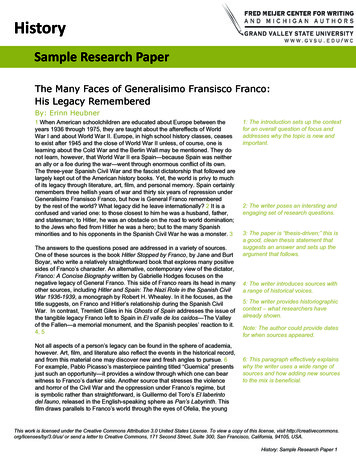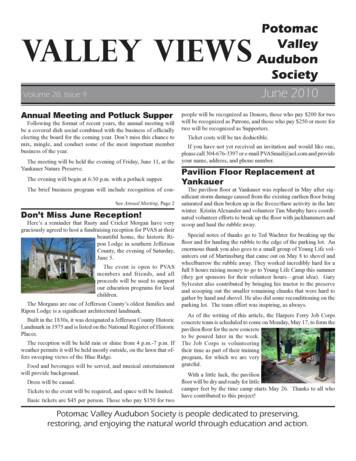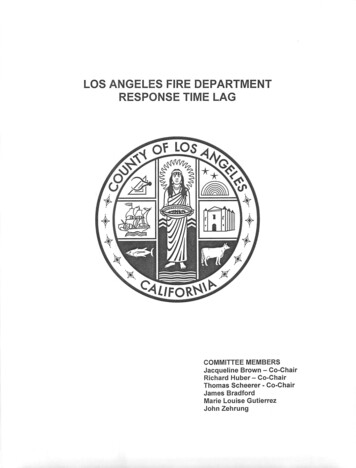
Transcription
HistorySample Research PaperThe Many Faces of Generalisimo Fransisco Franco:His Legacy RememberedBy: Erinn Heubner1 When American schoolchildren are educated about Europe between theyears 1936 through 1975, they are taught about the aftereffects of WorldWar I and about World War II. Europe, in high school history classes, ceasesto exist after 1945 and the close of World War II unless, of course, one islearning about the Cold War and the Berlin Wall may be mentioned. They donot learn, however, that World War II era Spain—because Spain was neitheran ally or a foe during the war—went through enormous conflict of its own.The three-year Spanish Civil War and the fascist dictatorship that followed arelargely kept out of the American history books. Yet, the world is privy to muchof its legacy through literature, art, film, and personal memory. Spain certainlyremembers three hellish years of war and thirty six years of repression underGeneralisimo Fransisco Franco, but how is General Franco rememberedby the rest of the world? What legacy did he leave internationally? 2 It is aconfused and varied one: to those closest to him he was a husband, father,and statesman; to Hitler, he was an obstacle on the road to world domination;to the Jews who fled from Hitler he was a hero; but to the many Spanishminorities and to his opponents in the Spanish Civil War he was a monster. 3The answers to the questions posed are addressed in a variety of sources.One of these sources is the book Hitler Stopped by Franco, by Jane and BurtBoyar, who write a relatively straightforward book that explores many positivesides of Franco’s character. An alternative, contemporary view of the dictator,Franco: A Concise Biography written by Gabrielle Hodges focuses on thenegative legacy of General Franco. This side of Franco rears its head in manyother sources, including Hitler and Spain: The Nazi Role in the Spanish CivilWar 1936-1939, a monograph by Robert H. Whealey. In it he focuses, as thetitle suggests, on Franco and Hitler’s relationship during the Spanish CivilWar. In contrast, Tremlett Giles in his Ghosts of Spain addresses the issue ofthe tangible legacy Franco left to Spain in El valle de los caídos—The Valleyof the Fallen—a memorial monument, and the Spanish peoples’ reaction to it.4, 5Not all aspects of a person’s legacy can be found in the sphere of academia,however. Art, film, and literature also reflect the events in the historical record,and from this material one may discover new and fresh angles to pursue. 6For example, Pablo Picasso’s masterpiece painting titled “Guernica” presentsjust such an opportunity—it provides a window through which one can bearwitness to Franco’s darker side. Another source that stresses the violenceand horror of the Civil War and the oppression under Franco’s regime, butis symbolic rather than straightforward, is Guillermo del Toro’s El laberintodel fauno, released in the English-speaking sphere as Pan’s Labyrinth. Thisfilm draws parallels to Franco’s world through the eyes of Ofelia, the young1: The introduction sets up the contextfor an overall question of focus andaddresses why the topic is new andimportant.2: The writer poses an intersting andengaging set of research questions.3: The paper is “thesis-driven;” this isa good, clean thesis statement thatsuggests an answer and sets up theargument that follows.4: The writer introduces sources witha range of historical voices.5: The writer provides historiographiccontext – what researchers havealready shown.Note: The author could provide datesfor when sources appeared.6: This paragraph effectively explainswhy the writer uses a wide range ofsources and how adding new sourcesto the mix is beneficial.This work is licensed under the Creative Commons Attribution 3.0 United States License. To view a copy of this license, visit http://creativecommons.org/licenses/by/3.0/us/ or send a letter to Creative Commons, 171 Second Street, Suite 300, San Francisco, California, 94105, USA.History: Sample Research Paper
female protagonist who is struggling in an atmosphere of parental oppression.Manuel Rivas, in his short story La lengua de las mariposas (or Butterflytongues), gives his readers a similar child-like perspective, but his is that of alittle boy who struggles to understand the changes in his life brought about bythe Civil War.One particularly interesting piece of literature that tries strenuously to highlightFranco as the family man is Hitler Stopped by Franco, a “novelized” history,written by Jane and Burt Boyar.1 Naturally one’s family would be hard-pressedto believe in the darker side of an individual. Franco’s family was no different.In their memories, as Jane and Burt Boyar would have one believe, he wasa loving and affectionate husband and father. On October 22, 1923, Francomarried Maria del Carmen Polo in a lavish public ceremony.2 The Boyarswould indicate that his wife revealed to them that her parents disapproved ofher choice in suitors, and she could not “have imagined that he would be asdevoted a husband and father as he was.”3 They portray her as privy to hisstrategies as ruler of Spain, and in their conversations in the book, CarmenPolo affectionately calls her husband Paco, the endearment common in theSpanish language for Fransisco: “Paco, what are you going to do about theGermans?”4 This would prove Franco to be accessible, intimate with his wife,and open with her about the state of Spain and his decisions regarding her. 7 7: In this paragraph the writercomments on the sources and authorswhile displaying an awareness of theGeneral Franco’s daughter, Carmen, was born on September 14, 1926.5source of the author’s bias.Carmencita’s memory according to the Boyars is similar. One of the firstincidences of her in the Boyars’ book is Franco’s concern for her safety-theconcerned father. The Boyars describe Franco’s choice in palaces after hecame to power:When he elected to move to the traditional capital, Madrid, hiswife, Carmen Polo, selected the Palace of Larios in the cityproper, but the Chief of Security vetoed the site because itwas surrounded by higher buildings from which a sniper couldshoot at the Generalisimo, his wife or daughter as they walkedin the garden.6 8Franco chose a more isolated, and therefore more secure location in which tohouse his family, the Palace of El Pardo.7 Another scene in the Boyars’ bookin which we see Carmen and her father together shows us Franco, the fatherand host: “He was happy to see Carmencita’s best friend, Maruja Jurado,and kissed her hello they (the Francos) encouraged her friends to visit.”8 InCarmencita’s own memory not only was Franco warm and intimate with hisfamily, but with her friends and visitors as well. 9While it may be true that Carmen Polo, Franco’s wife, and Carmencita hadthe closest relationship with the Generalisimo, there are two problems withthe portrait of loving husband and doting father painted by the Boyars. First,there is conflicting evidence. One year before Hitler Stopped by Franco waspublished, Gabrielle Ashford Hodges wrote Franco: A Concise Biography.One passage in particular deserves to be quoted at length, as the image itconjures is directly contrary to the one the Boyar’s offer: 10Carmen’s romantic notions cannot have lasted long. Althoughtheir marriage was more enduring than that of Franco’sparents, it was devoid of any sign of passion or great lovefrom the very start. Once his role as the gallant and knightlysupplicant for her favours was removed, Franco was exposedas a cold and physically inhibited man. More at easewith wooing women than winning their favours, he clearlypreferred the battlefield to the marital bed. The union becameincreasingly formal over the years, with Pacón (Franco’scousin) commenting that Franco always became particularlymorose and inhibited in his wife’s company.98: The writer provides context asnecessary.Note: Author’s awareness of problemswith evidence in sources.9: After providing context, the writerprovides analysis.10: This is a good portrayal of contraryevidence.History: Sample Research Paper
11 Hodges’s account and Pacón’s comment belie the image of Franco andhis wife snuggled in bed, she calling him Paco and asking him to sharehis next move for planning the future of Spain, in light of the Nazi army’sadvances in Europe.The second problem is that almost all of these instances come from thememory of Carmen Franco, Franco’s daughter, Duchess of Franco. Theproblem lies not in the woman, but in memory itself. The events that shedescribes as having taken place, as recorded by the Boyars, happened in1940, when Carmen was only fourteen years old. 12 By the time the Boyarsbegan their research into the topic—1969 at the earliest—Carmen was fortythree years old, and was remembering events and conversations almost threedecades past. In his book, The Past is a Foreign Country, David Lowenthalladdresses the issue of memory and how it can shape and misshape history.A common theme that Lowenthall addresses is that of memory and identity,and that we see ourselves as a construct of our memories. This can lead,Lowenthall explains, to false memories.10 Part of Carmen Franco’s identityresides in the memories she has of her father. Lowenthall tells his readersthat “a false recollection firmly believed becomes a fact in its own right.”11 Shewished to remember him as indulgent and doting, and so she did. And hemay have been, but she was young and probably removed from the politicalatmosphere in which he showed his other faces.11: The writer could also comment onHodges’ sources.12: This comment on nature ofmemory demonstrates awarenessof source limitations and of how thesource was produced. (The natureof memory is an important topic forhistorians.)13 Furthermore, Lowenthall argues that children remember things differentlythan adults do: “Children see and hear what is there; adults see and hearwhat they are expected to and mainly remember what they think they oughtto remember.”12 Carmen’s memories as a young girl focus on Franco thefather, because that is the Franco she knew. She undoubtedly was not privyto political meetings or even so-called grown up discussions between hermother and father. Her memories of her father are biased because of her agewhen those memories were formed. Perhaps the most troublesome, however,is the span of time between her recollections and the actual events. Almostthree decades passed before she reconstructed her memories for the Boyars.Lowenthall gives his readers an example of another woman, Marigold Linton,who believed that she could accurately reconstruct her memories from thirtyyears prior. She kept a diary for a year, highlighting events in her life, whichshe revisited two years later and again three or four years after writing itin 1972. 14 Lowenthall describes her findings: they “revealed that memorygrossly altered events recorded two years back; after three or four yearsmany items failed to trigger any recollection at all after six years one-thirdof her recorded events had entirely vanished from memory.”13 If after sixyears one-third of her memories were irretrievable, imagine how many wouldhave vanished by the thirtieth! Carmen Franco’s memories were genuine andvery real to her and her circumstances, but they may not be all that reliable.Regardless, Franco’s legacy for her is that of the family man.13: This paragraph also showsawareness of how sources areconstructed.15 Another positive piece to Franco’s legacy comes to us in the form ofhis position as a roadblock to Hitler in the Fürher’s ambition to conquer thecontinent of Europe. Germany’s army wanted into North Africa, and theyalso needed a strategic location from which they could blockade Britain’ssupply lines. This prime location was Gibraltar, the southernmost point of theSpanish mainland.14 Germany faced a problem, however: Gibraltar had beenunder British control since 1782, and Britain formally made it a royal colony in1830. The only way for German forces to reach Gibraltar was through Spain.Hitler began his provocations on June 27, 1940 with a large show of force atthe French-Spanish border.15 Franco stalled, waiting to do anything until hereceived a letter from Hitler on September 18. In this letter, Hitler outlined hisviews of the importance of this war in the future of Europe, and laid out whathe thought Spain’s role ought to be in it. Their role would, of course, be thecapture and occupation of Gibraltar with the aid of German equipment andforces under Spanish command.16 This letter, combined with the amassed15: This is a logical transition.14: Effectively shows the evidence thesource used.History: Sample Research Paper
armies at the border, reflects a kind of polite ultimatum: let my armies in, or beoccupied.Franco stalled again, responding to Hitler’s letter in his own, dated September22, 1940. He responded cleverly to Hitler’s offer of modern equipment andGerman troops to take Gibraltar.16 He wrote, “I agree with your view that itis possible to achieve the success of this operation within a few days by theuse of modern equipment and tried troops. In this sense the equipment whichyou offer me will be of great effect.”17 Franco responded in such a way thathe was properly appreciative of Hitler’s offer, but also in a way that rebuffedHitler’s attempt to bring German troops into Spain. After an unsuccessfulattempt to convince Franco that he should bring Spain into the war as an allyof Germany, the two dictators met in person for the first and last time on theSpanish-French border, at Hendaye.18 In his book Hitler and Spain: The NaziRole in the Spanish Civil War, Robert Whealey describes the October 1940event as a “chilly meeting.”19 Hitler, again, failed to convince Franco to takeGibraltar immediately.In February of the next year, Hitler again wrote to Franco, but this time usingstronger language: “I asked you to permit the German concentration offorces against Gibraltar to start by January 10th ”20 Hitler was growingincreasingly frustrated with General Franco’s ability to put him off, as Francodid in response to his February letter, with more pleasant, appreciative talkbut no action.21 Hitler sought to send a still more effective message. Later inthe same year, German U-boats torpedoed and sank the Monte Gorbea, aSpanish grain ship bound for Spain with much-needed wheat.22 Despite hiscountry’s desperate need for grain and staples to feed his people, Francodid not allow Hitler’s troops onto Spanish soil and on June 20, 1943, afteralmost three years, the German army left the Spanish border and retreatedback into France.23 Hitler did not take Gibraltar, and Franco is the man whois remembered for stopping what could have been a devastating blow to theBritish navy—a blow that could have changed the course of the war. 1718 In the course of disobeying Hitler’s thinly disguised demands, Franco alsosaved the lives of “at least 40,000” Jews fleeing France in front of the Germanarmy.24 In an article published in his honor after his death in The AmericanSephardi, Franco was credited with not only denying Hitler in his attemptto make Franco pass anti-Semitic legislation, but he also repealed the lawthat expelled the Jews from Spain in 1942. He also founded Departmentsof Jewish Studies in all the major Spanish universities, wrote a law givingpermission for public worship in all non-Catholic religions, and restored theTránsito Synagogue of Toledo into a museum of Judaism until the time whenit could be opened for worship again.25 In purposely going against Hitler byallowing refugees from Nazi France into Spain, and in his proactive approachto restoring positive official relations between the Catholic regime and theJewish people, Franco set a place for himself as hero in the minds and heartsof the international Jewish community as well as the Spanish one.However, General Franco had not always gone contrary to Hitler. Duringthe Spanish Civil War, from 1936 to 1939, the Republicans—the leftistparty—fought against the Nationalists—the conservative party—for controlof the government. General Franco, a highly skilled and courageous soldierand brigadier general by the age of 34, led the Nationalist armies.26 Manyof the men who followed him on the battlefields of North Africa followed himinto the war, so that the Nationalist cause had the benefit of professionallytrained soldiers while the Republican forces were mostly militia and civilians.Franco used the full power of the army and he took aid from Hitler. Whealeydescribes in Hitler and Spain that Franco “told the German ambassador thatthe services of the ‘Legion Condor could not be dispensed with.’”27 Francoused especially the Luftwaffe, since often he had the infantry support heneeded, being a respected general of the Spanish Army. 1916: The writer effectively introducesthe sources being addressed.17: This paragraph shows a strongchronological progression of events innarrative form; the chronology is usedto create strong transitions and logicalorganiztion. Also, the writer againeffectively sets up the context.18: This is a strong transition thatshows how Franco’s actions benefitedvarious groups.19: This paragraph develops furthercontext for assertions regardingFranco’s behavior.History: Sample Research Paper
One especially famous instance of the Luftwaffe bombing was Gernika,formerly the capital of the Basque Country in north-central Spain. Whealeydescribes the bombing in a rather sterile way:On April 26, 1937, the Luftwaffe bombed the Basque villageof Guernica. A few days later Franco’s forces capturedthe town and tried to deny the bombing for the sake ofinternational public opinion. This led to a series of chargesand countercharges, so that the story of this relatively minormilitary event became a study in morality, international law,and propaganda.28He goes on to explain that Gernika was an experiment in a new bombingcampaign that Franco decided not to pursue after public outcry ensued. Hedid consider it a success; however, with 1,000 civilians dead, they still missedwhat they aimed for—a munitions factory and a strategic bridge.29 Much of thecity was destroyed by fire. (See figure A below). 20 Franco worked with Hitlerduring the bloody Civil War to meet his own ends (what he envisioned forSpain), and in this one case especially, to be a practice range for the fledglingLuftwaffe.The means through which he accomplished those ends, however, oftencome under scrutiny and not just in historical or political circles. PainterPablo Picasso was born in Málaga, Spain in 1881. He was a supporter of theRepublicans and because of this, he lived most of his adult life in France. InJanuary of 1937, the Republican government commissioned a painting torepresent Spain’s struggle at an exhibition in Paris—a propaganda piece.After the bombing of the village, however, the painting was rededicatedto symbolize the suffering and horror that Gernika suffered, and so theRepublicans renamed it “Guernica.” The painting is completely devoid ofcolor, but Picasso painted it in black, white, and gray for a reason.30 Theblack represents the despair and hopelessness of the people of Gernika,mourning for the thousands of lives lost in the bombing. The white is meant tobe polarizing, a contrast to the darkness, emphasizing the innocent lives thatwere lost, but also symbolizing hope—hope that Spain would one day seepeace and an end to the bloody Civil War that claimed so many of its men,women, and children. (See Figure B below). 21Jane and Burt Boyar had something to say about the way Franco was ableto run the Civil War and his dictatorship after the war: “when you had to signdeath warrants for thousands of men, when you had to look into a prisoner’seyes and say, ‘Execute him,’ when ones’ emotions have been subjectedto all those things then perhaps understanding occurs before anger.”31The context of this statement is not to highlight the actions of the killing ofthousands or the execution of a political prisoner, but to emphasize theefficiency of Franco’s actions, his ability to be a statesman, and do what wasnecessary: “he tolerated the intolerable, accepted the unacceptable—anythingto save Spain.”32 The concept is too Machiavellian, however: the endlesslyparaphrased ‘the ends justify the means’ is no longer acceptable in a ruler.This statement by the Boyars, then, depending upon its reader, makes Francoseem somehow less than human, incapable of the emotion that stays one’shands from committing atrocities and makes his legacy ring more truly in therealm of monster. 22The most poignant example of this legacy is a film by writer, producer, anddirector Guillermo del Toro. The film is called El laberinto del fauno, or inEnglish, Pan’s Labyrinth. Del Toro released the film in 2007, thirty two yearsafter the end of Franco’s dictatorship. 23 The scene is set in 1944, after theofficial end of the Civil War, but there are still skirmishes between Francoansoldiers and leftist rebels. Ofelia, the main character, is a young girl whose20: In history writing, it is good toreference supportive figures/images.21: This is a good analysis of anillustration; illustration is effective herebecause it is not a filler, but instead isevidence as part of the argument.22: This is a good setup to lead intothe next paragraph.23: It is beneficial to give the historicalcontext of the film–attention is on thetime period of focus.History: Sample Research Paper
mother recently married a Captain in Franco’s army. Immediately the viewer,if they have any knowledge of Shakespeare’s works, should know thattragedy lies in the young girl’s future. Ophelia is the lover of Hamlet in theplay by the same name, and she meets an untimely demise. Ofelia is a freespirited young girl, and she disobeys often and gets herself into mischief.33She represents a free Spain, out from under the repression of Franco’sfascist regime. Her struggle mostly lies with her new stepfather, CaptainVidal, who represents Francoan authority. He is the only figure of authorityin the film and his authority is absolute. The caretaker of the mill where allthe main characters live is Mercedes, a leftist spy who provides intelligenceand sustenance to the rebels in the mountains. She is meant to be an olderversion of the Ofelia character.34 Both disobey the Captain’s authority andmake their own choices. 24There are two scenes in the film that blatantly show the ability of the Captainto be like Jane and Burt Boyar describe, without anger, but capable of doinghorrible things. One scene takes place at night, when the Captain is calledoutside to question two men—father and son—found walking in the mountainswith rifles. They are accused of being spies and rebels, but they insist thatthey were just hunting rabbits. The captain does not believe them. The sonsteps forward and speaks up to defend his father:24: In this paragraph, the writereffectively provides more informationregarding historical and literarycontext.—Captain, if my father says so, he was hunting rabbits.The captain does not respond but simply hits the son across the face with abottle he found in their pack and proceeds to beat the son’s face in with theblunt end of the bottle until his nose splinters and he dies. His father’s criesecho in the background:—You killed him! You killed him! Murderer! Son of a bitch!The captain very calmly turns to the father and shoots him through the heart.If one watches the captain’s face very carefully, one can see no emotionthere, but just an efficient army officer carrying out the everyday atrocitiesof fascist repression. Before he leaves his soldiers to clean up, he finds tworabbits in the same pack from which he pulled the wine bottle. He says to hissoldiers:—Maybe you’ll learn to search these assholes properly before you comebothering me.35This is the kind of nonchalant brutality that the Boyars bring to mind whenthey describe Franco as being able to sign the death warrants of thousandswithout getting angry. No man should order the deaths of thousands, let alonebe cool and collected while doing so.Another scene that evokes pity for the leftist rebels and highlights the controland oppression of Franco’s Spain is one in which the Captain hands out rationcards to the Nationalist villagers in the area. The idea is to keep the food,medicine, and other supplies locked up at the mill, doling them out bit by bitso that no one can either directly or inadvertently help the rebels by supplyingthem with anything. Even the priest sitting at the table does not seem troubledwith starving them to death and letting them die of disease, saying:—God has already saved their souls. What happens to their bodies hardlymatters to Him.The Catholic Church was one of Franco’s staunchest supporters. The Vaticaneventually gave him “full diplomatic recognition.”36 The Captain chillingly sumsit up:History: Sample Research Paper
—I want my son to be born in a new, clean Spain. Because these people holdthe mistaken belief that we’re all equal. But there’s a big difference: the war isover and we won. And if we need to kill every one of these vermin to settle it,then we’ll kill them all, and that’s that.This way of thinking was too much for some people, however. Ofelia’s mother,after discovering her daughter still believes in fairy tales, grows angry, andyells at her:—You have to stop all this.—No! I want to leave this place! Please, take me away from here! Let’s justgo, please!—Things are not that simple. You’re getting older, soon you’ll see that life isn’tlike your fairy tales. The world is a cruel place. And you’ll learn that even if ithurts —No! No!—Ofelia! Magic does not exist! Not for you, me, or anyone else.37Her mother has lost hope, not just in fairy tales and magic as the conversationsuggests, but in the ability of Spain to recover, to thrive under the repressiveregime of Franco.Ofelia has hope, however, and the viewer can see it in two things. First of all,she has her fairy tales. She creates for herself an alternate reality that shecan escape to when the real world of her stepfather’s oppressive environmentgets to be too much for her. In her alternate reality, she is a princess froma fairy kingdom underground and to get back there, all she has to do iscomplete three tasks, then she will be immortal again and return to her truedestiny in the land of fairies and magic, free of suffering. Del Toro uses colorsas symbols in this film, and it is excellently done. The harsh, oppressivereality of the Captain is shot mainly with cold colors, muted colors: blue,green, and gray. The alternate reality is shot in rich colors of red, orange,and gold. Second, at the end of the film, the viewer realizes that the journeythat Ofelia took—from a carefree young girl, to suffering under the captain’sroof and rules and dying at his hand and then being resurrected as her truefairy princess form—this is the journey that Spain took under General Franco:from relative peace before the Civil War, to suffering under Franco’s war and36-year-long regime, to being resurrected into the modern Spain under therule of a democratic monarchy. Guillermo del Toro put it beautifully when hewrote on the film’s web site: “Franco suffocated Spain for decades as he triedto fashion it after what he believed to be ‘good for her.’ Yet Spain didn’t die;she exploded, vibrant and alive, in the 80s. Spain lived the 60s in the 80s andthey are still feeling the aftershocks of such a wonderful explosion.”38 The girlbelieved enough in her magic, in her fairy tales, not to be afraid even as deathtook her; because she knew something better awaited her on the other side;because she made the brave choice not to sacrifice the innocent and to holdon to hope.Ofelia’s perspective is almost unique, because it is a perspective not oftenexplored in history. It presents the world of Franco through the eyes of achild. 25 Manual Rivas also explores this child’s perspective in his short storyLa lengua de las mariposas. In his story, Pardal is a young boy who is juststarting school for the first time. His father is a Republican sympathizer andhis mother is a Nationalist. After a traumatic experience his first day at school,the boy forms a bond with his teacher who helps him to understand the worldof creatures that live right in his mountainous backyard. Two of his favoritesare the toad, because it reminds him of his teacher, and a butterfly called theIris that “brillaba hermosisima posada en el barro o el esiércol”39 (that shone25: This is an effective shift fromOfelia to Manual Rivas.History: Sample Research Paper
most beautifully laid in the mud or manure). His parents revel in the attentionhe receives from the teacher and the progress he makes in his studies. Hisfather, a tailor, even makes a new suit to show the teacher their gratitude.When the Civil War struck and the Nationalist police came to their village andbegan taking prisoners, Pardal’s mother took him aside and told him “convoz muy grave: Recuerda esto, Moncho, Papá no era republicano. Papáno era amigo del alcalde. Papá no hablaba mal de los curas. Y otra costmuy importante, Moncho. Papá no le regaló un trage al maestro”40 (in a veryserious tone: Remember this, Moncho, Daddy was not a Republican. Daddywas not a friend of the mayor. Daddy did not talk badly about priests. And oneother very important thing, Moncho. Daddy did not give a suit to the teacher).The boy is confused: “Sí que se lo regaló” (But he did give it to him). “No,Moncho. No se lo regaló. ¿Has entendido bien? ¡No se regaló!” (No, Moncho.He did not give it to him. Do you understand me? He didn’t give it to him!).Moncho responds, “No, mama, no se lo regaló” (No, Mom, he didn’t give it tohim).41 Then the whole town gathers in the courtyard in front of City Hall, andthe police bring out the political prisoners. His teacher is among them.The crowd begins to shout, call them names, and accuse t
was surrounded by higher buildings from which a sniper could shoot at the Generalisimo, his wife or daughter as they walked in the garden.6 8 Franco chose a more isolated, and therefore more secu










